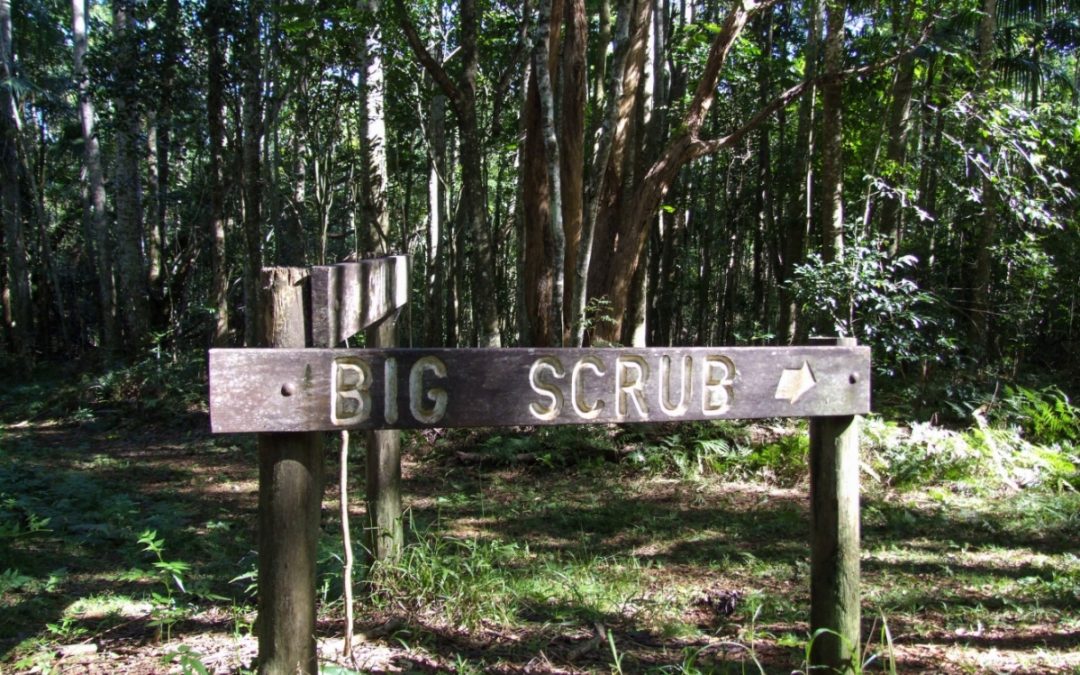A contribution from Big Scrub Landcare member Ken Dorey.
I’ve always been a little disappointed that European settlers didn’t come up with a better name than ‘Big Scrub’. But with so much being unfamiliar to them, it’s understandable that many descriptive, rather than imaginative, names – like red bean, iron bark or bleeding heart – were adopted.
Understanding the origins of how place and species names evolved in the area is a study in etymology – one that I will attempt with insights from historical archives and input from our community’s Bundjalung people. I welcome anyone with additional knowledge to contribute it to the article via info@bigscrubrainforest.org.
The Richmond River was given its European name by Captain Henry Rous in 1828 – a name that was cemented in the 1840s when the cedar-getters began to arrive. The area was further mapped in 1856, when a public gazette was published in the Empire newspaper declaring the site of the town of Ballina – a name many believe derived from the Aboriginal place-name Bullenah, meaning “place where oysters are plentiful.” Although, according to Place Names of the Richmond Region, Government Surveyor Burnett’s map of 1845 spelt what is now Ballina as Bul-loona – believed to be derived from the generic Bundjalung word for river.
How was “Big Scrub” named?
For thousands of years the Bundjalung people called the Big Scrub, or at least rainforest, Gabal.
It was not until the 1860s that the term ‘Big Scrub’ began to emerge, so-named for the size and density of the forest. The first references to ‘Big Scrub’ in the local records I can find are in Australian Town and Country newspaper in 1872 and in the newly published Northern Star in 1876.
But by 1882 the Big Scrub had seemingly become famous! According to the Clarence and Richmond Examiner, in an article titled ‘Trip to the Richmond River‘ the Big Scrub: “can hold its own with the most fertile coast district in the colony, instancing the famous Big Scrub which, I suppose, every child within a radius of 300 miles must have heard of – which they do not fail to paint in the most glowing terms”.
In close approximation
As for other names, there are many that are derived from, or written in the closest approximation of, Aboriginal words.
According to Place Names of the Richmond Region (PNRR): “early settlers, surveyors, road-builders, postmasters and teachers liked to give Aboriginal names to places”. It also notes however due to differing sounds between the languages, many names were written in best-guess English. For example, Tucki Tucki, was originally pronounced more like Chookie Chookie.
Despite so much being lost in translation, Bundjalung names do live on in many place names. Many of these end with the ‘bil’ or ‘bah’ sound, which, according to PNRR, can mean “possessive case or present location” or “place of”.
Here are just a few:
- Binna Burra: place of beech trees
- Buckombil: place of the black bean
- Caniaba for the short-necked tortoise;
- Chickiba for the cat bird
- Coorabell (more correctly Goorangbil) for the hoop pine;
- Goolmangar for the water gum
- Goonellabah for the native coral tree
- Jiggi also for the cat bird
- Keerong for the flying fox
- Midgen (Midgin) Flat for the walking stick palm (though a similar sounding word refers to red edible berries)
- Mulgum Creek is named for the native raspberry
- Newrybar (Nurybar) for the short length of vine used to climb trees
- Tyagarah for the open grass country
- Teven (more correctly Tyihbin) for the stinging tree.
Two of my favourite place names are Tintenbar, which is said to mean place of short-tailed pademelon, wild cucumber or place of strong winds, and Tuckombil, which is said to mean junction of two creeks, salt water creek, place of black swamp fowls or redbills.
The history of names in the area is a fascinating one, and I would love to hear from anyone with any other interesting insights into the names of the Big Scrub. Let’s continue to share the knowledge of the rich, ancient history of our beautiful rainforest region.


